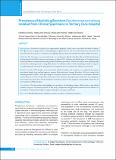Please use this identifier to cite or link to this item:
https://hdl.handle.net/20.500.14356/931Full metadata record
| DC Field | Value | Language |
|---|---|---|
| dc.contributor.author | Sharma, Samikshya | - |
| dc.contributor.author | Devkota, Madhu Dixit | - |
| dc.contributor.author | Pokhrel, Bharat Mani | - |
| dc.contributor.author | Banjara, Megha Raj | - |
| dc.date.accessioned | 2023-04-06T08:51:48Z | - |
| dc.date.available | 2023-04-06T08:51:48Z | - |
| dc.date.issued | 2022 | - |
| dc.identifier.citation | SharmaS., DevkotaM. D., PokhrelB. M., & BanjaraM. R. (2023). Prevalence of Multidrug Resistant Pseudomonas aeruginosa Isolated from Clinical Specimens in Tertiary Care Hospital. Journal of Nepal Health Research Council, 20(3), 586-592. https://doi.org/10.33314/jnhrc.v20i3.4265 | en_US |
| dc.identifier.issn | Print ISSN: 1727-5482; Online ISSN: 1999-6217 | - |
| dc.identifier.uri | http://103.69.126.140:8080/handle/20.500.14356/931 | - |
| dc.description | Original Article | en_US |
| dc.description.abstract | Abstract Background: Pseudomonas aeruginosa is an opportunistic pathogen, which causes nosocomial infections in human. The rapid increase in drug resistance of this pathogen is a global concern. The aim of this study was to determine the clinical burden of P.aeruginosa, its antibiotic susceptibility pattern along with metallo-β-lactamase (MBL) detection. Methods: The descriptive cross-sectional study was conducted in Upendra Devkota Memorial National Institute of Neurological and Allied Sciences from January to August 2021. Isolation and identification of P. aeruginosa from clinical specimens was performed by using standard laboratory procedure. All bacterial isolates were phenotypically screened for multidrug resistance using Kirby Bauer disc diffusion method. All the multidrug resistant P.aeruginosa were phenotypically screened for MBL producer by Imipenem-EDTA combined disc diffusion test (CDDT). Results: A total of 770 samples were processed of which 36 isolates of P. aeruginosa were obtained. P.aeruginosa was isolated mainly from tracheal aspirates, sputum, blood and urine. Among 36 isolates, 50% were found to be multidrug resistant (MDR). More percentage of P.aeruginosa isolates were found resistant to aztreonam, ofloxacin and levofloxacin (52.8%). Furthermore, this study reveals antibiotics like piperacillin/tazobactam and carbapenem were found to be good choice for the treatment of infection caused by this organism. Among MDR isolates 66.7% were found to be MBL producer. Conclusions: The data in this study highlights the prevalence of multidrug resistant, MBL producer, and colistin resistant P.aeruginosa in clinical specimens. In this study, carbapenems and piperacillin/tazobactam were found to be most effective antimicrobial drugs for empirical therapy in P.aeruginosa infections. Keywords: Metallo-β-lactamase; multidrug resistant; prevalence; Pseudomonas aeruginosa. Author Biography Bharat Mani Pokhrel, Upendra Devkota Memorial National Institute of Neurological and Allied Sciences, Bansbari, Kathmandu, Nepal Professor of Microbiology | en_US |
| dc.language.iso | en | en_US |
| dc.publisher | Nepal Health Research Council | en_US |
| dc.relation.ispartofseries | July-Sep, 2022;4265 | - |
| dc.subject | Metallo-β-lactamase | en_US |
| dc.subject | multidrug resistant | en_US |
| dc.subject | prevalence | en_US |
| dc.subject | aeruginosa | en_US |
| dc.title | Prevalence of Multidrug Resistant Pseudomonas aeruginosa Isolated from Clinical Specimens in Tertiary Care Hospital | en_US |
| dc.type | Journal Article | en_US |
| Appears in Collections: | Vol 20 No 3 Issue 56 july-Sep, 2022 | |
Files in This Item:
| File | Description | Size | Format | |
|---|---|---|---|---|
| 4265-Manuscript-30761-1-10-20230314.pdf | Fulltext Article. | 663.91 kB | Adobe PDF |  View/Open |
Items in DSpace are protected by copyright, with all rights reserved, unless otherwise indicated.
